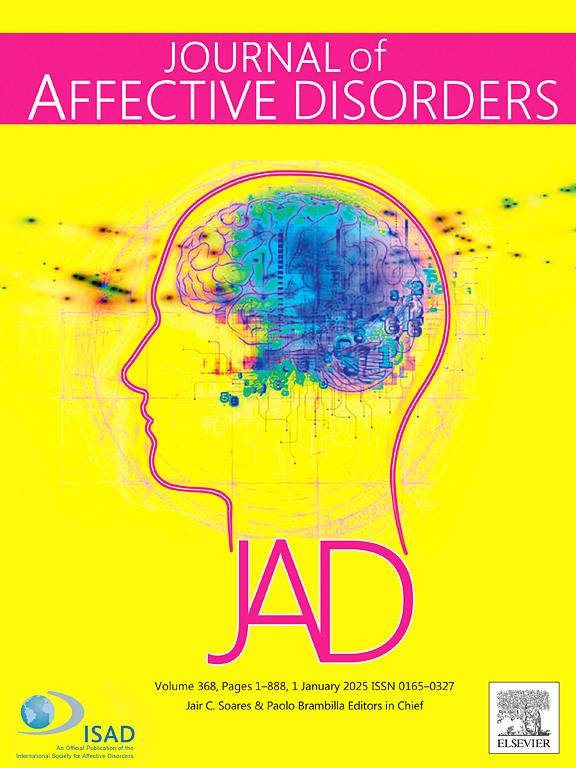南非农村少女和年轻女性家庭经济冲击、抑郁和应激反应生物标志物升高之间的关系(HPTN 068)。
IF 4.9
2区 医学
Q1 CLINICAL NEUROLOGY
引用次数: 0
摘要
背景:常见的精神健康障碍(CMDs)显著增加了少女和年轻妇女(AGYW)的全球疾病负担。在南非,患有慢性疾病的老年妇女比例很高,这在一定程度上反映了早年生活中的逆境和由此产生的慢性压力,特别是由于暴露于恶劣的经济条件,如频繁的家庭经济冲击。然而,关于家庭经济冲击、慢性疾病和老年妇女慢性压力之间关系的纵向证据有限。方法:数据来自南非农村HIV预防试验网络(HPTN) 068研究(2012-2019)。AGYW在基线时为13-20岁,每年随访长达6 年。暴露包括任何休克经历、休克类型(疾病/死亡、农业、财富)和休克次数(0、1、≥2)。我们计算了暴露与抑郁症状之间关联的风险比(CESD-10 > 16),并按资助收据分层,以及暴露与应激反应性生物标志物(c反应蛋白(CRP)、巨细胞病毒(CMV)、1型单纯疱疹病毒(HSV-1))和HIV感染之间关联的优势比。结果:在1892名AGYW中,未经调整的分析表明,经历任何电击(RR: 1.10, 95 % CI: 1.00-1.22)或电击增加(RR: 1.05, 95 % CI: 1.00-1.11)与抑郁症状之间存在关系。在调整分析中,经历任何冲击(OR: 1.21, 95 % CI: 1.04-1.34),增加的冲击(OR: 1.19, 95 % CI: 1.03-1.38)和财富冲击(OR: 1.20, 95 % CI: 1.03-1.29)与CRP升高相关。我们没有发现电击和HIV感染之间的关系。结论:在青春期早期经历经济逆境的AGYW在向成年过渡期间抑郁症状和应激生物标志物水平升高的风险增加。本文章由计算机程序翻译,如有差异,请以英文原文为准。
The relationship between household economic shocks, depression, and elevated stress-responsive biomarkers among adolescent girls and young women in rural South Africa (HPTN 068)
Background
Common mental health disorders (CMDs) significantly contribute to the global burden of disease among adolescent girls and young women (AGYW). In South Africa, the high proportion of AGYW experiencing CMDs in part reflects adversity in early life and resulting chronic stress, particularly through exposure to poor economic conditions such as frequent household economic shocks. Yet, longitudinal evidence for the relationship between household economic shocks, CMDs, and chronic stress among AGYW is limited.
Methods
Data are from the HIV Prevention Trials Network (HPTN) 068 study in rural South Africa (2012–2019). AGYW, 13–20 at baseline, were followed annually for up to 6 years. Exposures included experience of any shock, type of shock (illness/death, agricultural, wealth), and number of shocks (0, 1, ≥2). We calculated risk ratios for the association between exposures and depressive symptoms (CESD–10 > 16)), stratified by grant receipt, and odds ratios for the association between exposures and stress-responsive biomarkers (C-reactive protein (CRP), cytomegalovirus (CMV), herpes simplex virus type-1 (HSV-1)) and HIV infection.
Results
Among 1892 AGYW, unadjusted analyses suggested a relationship between experiencing any shock (RR: 1.10, 95 % CI: 1.00–1.22), or increased shocks (RR: 1.05, 95 % CI: 1.00–1.11), and depressive symptoms. In adjusted analyses, experiencing any shock (OR: 1.21, 95 % CI: 1.04–1.34), increased shocks (OR: 1.19, 95 % CI: 1.03–1.38), and wealth shocks (OR: 1.20, 95 % CI: 1.03–1.29) were associated with increased CRP. We found no relationship between shocks and HIV acquisition.
Conclusion
AGYW experiencing economic adversity in early adolescence are at increased risk for depressive symptoms and elevated stress-biomarker levels during the transition to adulthood.
求助全文
通过发布文献求助,成功后即可免费获取论文全文。
去求助
来源期刊

Journal of affective disorders
医学-精神病学
CiteScore
10.90
自引率
6.10%
发文量
1319
审稿时长
9.3 weeks
期刊介绍:
The Journal of Affective Disorders publishes papers concerned with affective disorders in the widest sense: depression, mania, mood spectrum, emotions and personality, anxiety and stress. It is interdisciplinary and aims to bring together different approaches for a diverse readership. Top quality papers will be accepted dealing with any aspect of affective disorders, including neuroimaging, cognitive neurosciences, genetics, molecular biology, experimental and clinical neurosciences, pharmacology, neuroimmunoendocrinology, intervention and treatment trials.
 求助内容:
求助内容: 应助结果提醒方式:
应助结果提醒方式:


